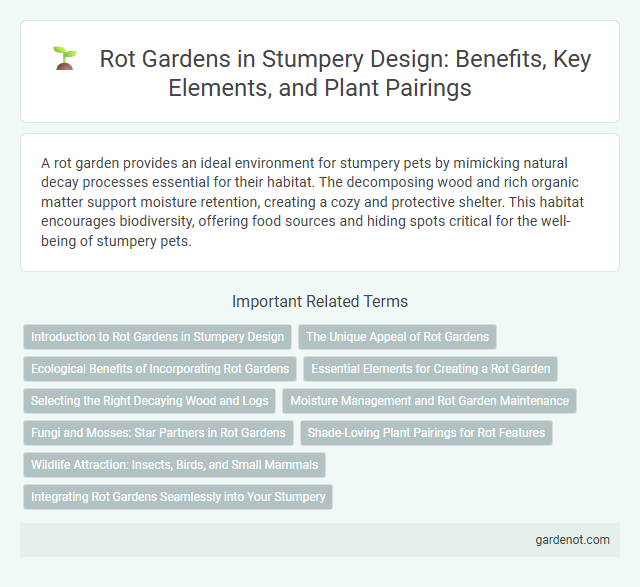A rot garden provides an ideal environment for stumpery pets by mimicking natural decay processes essential for their habitat. The decomposing wood and rich organic matter support moisture retention, creating a cozy and protective shelter. This habitat encourages biodiversity, offering food sources and hiding spots critical for the well-being of stumpery pets.
Introduction to Rot Gardens in Stumpery Design
Rot gardens in stumpery design emphasize natural decomposition processes, integrating decaying wood and organic matter to create rich habitats for fungi, insects, and plants. These gardens enhance soil fertility and biodiversity by mimicking woodland ecosystems where rot plays a crucial ecological role. Incorporating rot gardens into stumperies fosters a sustainable environment that supports diverse flora and fauna while promoting ecological balance.
The Unique Appeal of Rot Gardens
Rot gardens offer a unique appeal by transforming decaying plant matter into a rich, nutrient-dense humus that enhances soil fertility and promotes sustainable gardening. Their natural decomposition process supports diverse microbial life, improving soil structure and water retention. This eco-friendly approach not only recycles organic waste but also fosters a healthier ecosystem within the stumpery environment.
Ecological Benefits of Incorporating Rot Gardens
Rot gardens enhance soil fertility by accelerating organic matter decomposition, enriching nutrient cycling, and promoting diverse microbial activity. This ecological approach supports sustainable plant growth and improves water retention, reducing the need for chemical fertilizers. Integrating rot gardens into landscaping encourages biodiversity by providing natural habitats for decomposers and beneficial soil organisms.
Essential Elements for Creating a Rot Garden
Essential elements for creating a rot garden include well-decomposed organic matter such as leaf litter, wood chips, and compost, which provide a rich habitat for fungi and invertebrates. Moisture retention through shaded, damp conditions promotes effective decomposition and supports diverse microbial life. Incorporating varied textures and sizes of wood, alongside native mosses and ferns, enhances biodiversity and mimics natural rot.
Selecting the Right Decaying Wood and Logs
Choosing the right decaying wood and logs for a stumpery enhances habitat creation and aesthetic appeal, with hardwoods like oak and beech providing sturdy, long-lasting structures rich in biodiversity. Avoid chemically treated or resinous woods such as pine, as they release toxins harmful to fungi and invertebrates vital for decomposition. Logs in various stages of decay support a diverse ecosystem, attracting fungi, mosses, and insects essential for nutrient cycling in a rot garden environment.
Moisture Management and Rot Garden Maintenance
Effective moisture management in a rot garden is essential for preventing fungal decay and promoting healthy decomposition of organic materials. Regular monitoring of soil dampness and adjusting water levels ensures optimal conditions that discourage harmful rot while supporting beneficial microbial activity. Proper rot garden maintenance includes removing excess moisture, aerating soil, and periodically turning organic matter to maintain an ideal balance between moisture and air circulation.
Fungi and Mosses: Star Partners in Rot Gardens
Fungi and mosses form vital components of rot gardens, breaking down organic matter and enriching soil fertility. These organisms accelerate decomposition, creating a nutrient-rich environment that supports plant growth and biodiversity. Their presence fosters a balanced ecosystem, enhancing the natural recycling processes within rot gardens.
Shade-Loving Plant Pairings for Rot Features
Shade-loving plants such as ferns, hostas, and hellebores thrive in rot garden stumpery features, creating a lush, textured understory that complements decaying wood. Pairing moisture-loving species like astilbes or Solomon's seal enhances the damp, shaded microenvironment typical of rot gardens. Incorporating these plants not only accelerates wood decomposition but also promotes biodiversity and soil health within the stumpery.
Wildlife Attraction: Insects, Birds, and Small Mammals
A rot garden in a stumpery creates a rich habitat by accumulating decaying wood, attracting diverse insects such as beetles and spiders that play key roles in decomposition. The abundance of insects draws insectivorous birds like robins and wrens, enhancing biodiversity and natural pest control. Small mammals, including hedgehogs and shrews, find shelter and food within this ecosystem, promoting a balanced and thriving garden environment.
Integrating Rot Gardens Seamlessly into Your Stumpery
Integrating rot gardens seamlessly into your stumpery enhances natural decomposition while supporting biodiversity by creating a rich habitat for fungi, insects, and microorganisms. Positioning decaying wood strategically within shaded, moist areas mimics woodland forest floors, accelerating nutrient cycling and improving soil fertility. Incorporating native plant species alongside rotting timber ensures a balanced ecosystem, promoting sustainable growth and visual harmony.
Rot garden Infographic

 gardenot.com
gardenot.com